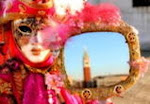Thursday, January 28, 2016
The Fringes
Going through my files tonight, I came across this crude map I'd drawn of my immediate neighborhood, back in 2008. It was obviously meant to be somewhat humorous, but it was also meant to illustrate a particular problem at the time.
What happened was, I had found a set of knives (marked in red text, above) on the ground outside my bedroom window. This was disturbing, but it was not possible to tell if someone had been lurking outside the window for some nefarious purpose, or if they had been hidden there after a crime, or they had been flung there by someone needing to get rid of them fast (for instance, a parolee who'd just seen a cop).
We took the knives to the police station, and while the cops seemed unimpressed, it was still worrying. I drew this map illustrating how all three scenarios had potential, and posted it to an internet forum so my online friends could give it a look. (For the record, most people thought scenario 3 - someone running from the Forlorn Intersection had flung them there - was the correct one and since nothing ever came of it, I assume they were right.)
Looking back on it now, though, what I see is a psychogeographical map of a fringe area. Fringe areas are of particular interest to me, being transitional places where one thing becomes another. Fringe areas are often overlooked, even though they are around us all the time. Entrance ways and exits, alleys, the outskirts of towns. Fringe areas are also frequently places where crime is more likely to occur - though I hasten to add, my family never personally experienced any crime there.
There were a few transitions occurring in the scope of this map. First (and most noticeable in person) was the petering out of the gentrified neighborhood of restored houses into unrestored houses and then, across the tracks (off the map) into dusty slums. There was an overlapping of social backgrounds and economic status. Then there is the blending of traditionally racially identified areas. Many different types of people came together in this street.
Studying the map (and also from memory) the true fringe area must have been the Forlorn Intersection. I knew quite a few very nice people who lived on the other side, but that intersection - just a drab little road, really - was always the place where things went down.
It's interesting to note that right on the edge stood the convent house - A Poor Clare monastery, to be exact. Quiet, peaceful, shining like a beacon on prayer nights. No one ever, ever messed with the Poor Clares. Regardless of status, they were there for everyone.
All these years later, it occurs to me that there should be many more things marked on the map. Like the house with stained-glass windows, or the silent hedges. I feel lucky that some of these things are captured in the early part of this blog (which was kind of the point, really). But there are other things that aren't so easy to capture. Dust and silt. Humming streetlights.The church carillon that rang every day at 8, 12 and 5. These are little things that make up the secret nature of a place.
One white hot summer day, my friend Arturo was riding past on his bicycle and we stopped to talk. He waved a copy of the local newspaper. "Did you hear? About the creature?" he asked, pointing at the front page picture of the Cuero chupacabra. We both thought it was fascinating, but agreed that sometimes things were better if we never learned the whole truth.
If I could, I would put that on the map, too.
(apologies - I ended up posting this yesterday before it was finished. (long story))
Labels:
houses,
maps,
neighborhood,
Poor Clares,
psychogeography,
Victoria
Subscribe to:
Post Comments (Atom)









No comments:
Post a Comment